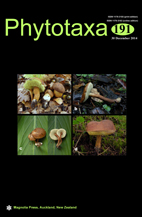Abstract
The genus Imleria can be easily distinguished from other genera of Boletaceae by the combination of the following characters: a chestnut brown pileus and stipe, a cream to pale yellow hymenophore, a viscid pileal surface when moist, a cyanescent context and hymenophore on handling or exposure, an ixotrichodermal pileipellis and smooth spores. The monophyly of Imleria and the detection of four independent species were highly supported by phylogenetic analyses using 5 gene markers. The four species, including the previously recognized Im. badia, Im. obscurebrunnea, plus the newly discovered Im. parva and Im. subalpina, are fully documented with taxonomic descriptions and illustrations, and a key to the taxa is provided. Geographically, Im. badia is widely distributed in Europe, North America and probably in Far East Asia, yet there is some intraspecific divergence between specimens from Europe and North America caused probably by geographic isolation. Imleria subalpina and Im. obscurebrunnea might diverge from each other relatively recently with the uplifts of the eastern Himalayas and Hengduan Mountains. An epitype collected from Sweden was designated for Im. badia.

